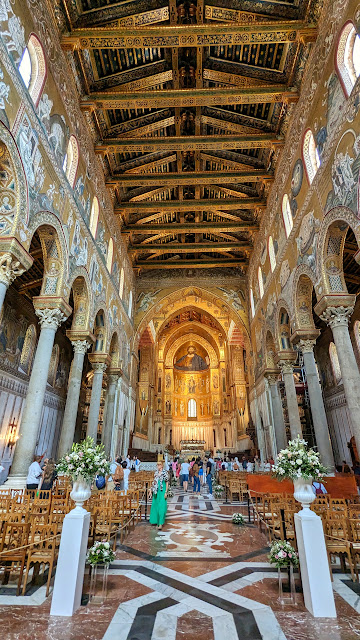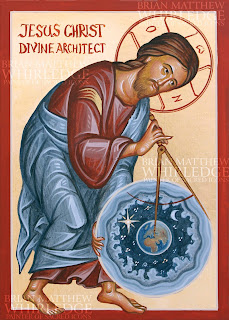The Duomo of Monreale
After spending over an hour and a half at Martorana, we walked about 15 minutes through the Porto Nuovo to Piazza Independenza to take the 389 bus to Monreale. The four-mile route took 40 minutes through stop-and-go congested Italian traffic, in which there are apparently no laws or rules. Tiny cars would swerve out in front of the bus, forcing the bus to slow, while the bus disregarded stop signs and making others yield to us. Once we reached Monreale, we walked about 10 minutes to the Piazza Vittorio Emmanuele north of the Cathedral (Duomo). We ate delicious pizza for lunch while we waited for the Duomo to reopen at 2.
The see of the Archbishop of Palermo moved to the nearby village during Arab occupation. When the Normans liberated Sicily in the 12th century, this area became the royal hunting grounds. The Norman royalty built a palace here, giving it the name "Monreale" or "Royal Mountain." It shares a variation of the same name as Montreale. The young crown prince William II had a vision of the Mother of God while he was hunting. She commanded him to built a magnificent cathedral here and showed him a place where a great treasure was buried which he could use to finance its construction. It is estimated there is almost 5,000 pounds of gold decorating the interior.
The Cathedral of Monreale is worth the visit to Sicily by itself. Its grand scale and artistic excellence are simply unparalled. While we think of icons primarily as painted today, in the 12th century and earlier, mosaic was considered the highest form. After the Venetian sack of Constantinople in 1204, the resources simply did not exist for such luxurious decor, and the much cheaper fresco became the leading medium. This church was completed in 1182, at the height of Byzantine mosaic art, just 22 years before the Venetians plundered Constaninople, which never fully recovered.
The iconographic programme of Monreale is very similar to the much smaller Palatine Chapel, but on a monumental scale. The Palatine chapel could fit lengthwise across the nave of the Monreale Duomo. The scale of this church is breathtaking, especially after having just visited the much smaller churches of Martorana and Cappella Palatina. The artistic level was in no wise compromised for the grand scale of these mosaics.
The apse prominently features a masterful Christ Pantocrator (the Almighty). Below Him is His Mother, enthroned. I've referenced this magnificent mosaic in several projects through the years. I was so excited to see her in person! She is flanked by angels (asShe is the true and living Ark and Taberncale), and futher saints surround them. The Crossing (transept) shows the great feasts from the life of Christ. Sadly, the crossing is filled with scaffolding for restoration work, so those mosaics were not visible. In 2024, the apse will be undergoing restoration. Monreale will be fully open in 2025, God-willing (Cefalu should reopen in January or February 2024).
The nave features a narrative of the whole book of Genesis, greatly expanded from the programme in the Palatine Chapel. The mosaics of the Creation of the world are especially beautiful. The aisles tell Christ's miracles throughout his ministry.
As I was drawing and studying, workers began to fill the church with flowers for a 4:00 wedding, and certain sections were roped off from visitors. A kind nun noticed I was sketching and invited me into the choir, just in front of the high altar and just underneath the grand mosaic of Christ Pantocrator and the Theotokos Enthroned. A sexton was preparing the altar for the wedding Mass, and questioned me, since I was in a place roped off and prohibited to tourists, but consulting the nun, I was allowed to stay and sketch. She insisted on taking a photo of me in front of the apse and high altar. It was a real blessing to be so close to these magnificent and influential mosaics! I left a few minutes before the 4:00 wedding as guests began to arrive, totally amazed and thankful for seeing these incredible mosaics.















Comments
Post a Comment